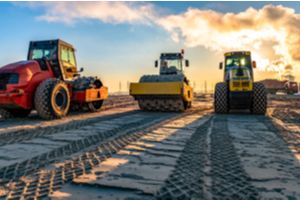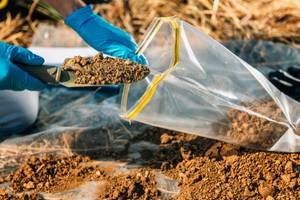Most of the buildings, roads and other types of construction found around the world are built on top of soil. This abundant resource can serve as an excellent foundation for all manner of construction, but understanding its properties and how movement and the elements can change its characteristics is essential for ensuring that whatever is constructed on top of it will stand the test of time.
What Is Soil Consolidation?
One factor that needs to be considered in construction is soil consolidation. This is a natural process that occurs to soil when steady and static pressure leads to the compression of saturated soil and reduces its volume slowly over time.
Natural loads, such as processes of sedimentation, can cause soil consolidation. However, a bigger concern in construction is how human-made loads such as the weight of foundations and buildings cause consolidation to occur.
To ensure that structures built on a compressible soil layer will be safe and strong, it is important to understand consolidation theory and predict the magnitude and rate of consolidation settlements.
There are three components involved in the consolidation of soil. Here is a closer look at each one.
Initial Consolidation
Any time a load is applied to soil that is partially saturated, it will experience a reduction in volume as the air in the void is expelled and compressed. In addition, its volume will decrease slightly as a result of the compression of solid particles.
This reduction in the soil’s volume that is noted immediately after the application of the load is called initial consolidation. It may also be referred to as elastic settlement, although some experts feel this is a misnomer. In saturated soils, initial consolidation is largely the result of compressing solid particles.
Primary Consolidation
A further reduction in volume occurs following initial consolidation as water is expelled from the voids in the soil. When saturated soil is subjected to pressure, the applied pressure will be taken up by water in the form of excess pore water pressure at first.
Then, a hydraulic gradient develops and water begins to flow outward, leading to a decrease in volume known as primary consolidation or consolidation settlement.
In soils with a coarse grain, primary consolidation takes place relatively quickly thanks to the soil’s high permeability. In fine-grained soils, however, primary consolidation may take a much longer period of time.
Secondary Consolidation
After the excess hydrostatic pressure that was formed by the applied pressure has fully dissipated and primary consolidation is completed, the soil will continue to note a decrease in volume at a slow rate over time.
This further reduction in soil volume is known as secondary consolidation, or creep settlement, and it is a particularly important consideration for soft organic clays and peat soil. The rate of this consolidation is assumed to decay exponentially over time following the application of the load and can be predicted using a formula.
How Soil Consolidation Influences Construction
Understanding the processes involved in soil consolidation and factoring them into the design stage of a project can help reduce the potential for dangerous settling and other expensive issues that can occur to the finished project over time.
For example, failing to account for consolidation could result in issues such as cracking in the facade, damaged utilities entering the building, or an uneven slab in the future.
Engineers measure the potential for consolidation of the land where a building is being constructed to ensure it can be designed in a way that accounts for the expected degree of settlement.
Another way that soil stability is ensured in construction is via a process known as soil compaction. This is routinely carried out before construction gets underway to ensure the foundation of the project will be strong and to further reduce the chances of settlement occurring.
Soil Consolidation Versus Soil Compaction
Soil consolidation and compaction are two different processes that can both improve the strength and bearing capacity of soil in addition to decreasing its compressibility and permeability.
While consolidation is a slow process that occurs naturally under long-term, static loading, soil compaction is a deliberate process that is carried out using equipment such as trench rollers, rammers and forward reversible plates. This equipment is used to expel air from the voids of the soil to help achieve the soil’s maximum dry density, and it works on all types of soil.
Estimating Soil Consolidation
Geotechnical engineers rely on predictions of the amount of settlement that may take place beneath the foundation of a project. This is achieved by making approximations of the applied stresses to determine the likely degree of consolidation.
Samples are typically taken of the soil and then subjected to lab testing and computer modeling programs of stress distributions to determine the expected consolidation.
The Oedometer test is a popular testing procedure for quantifying the critical soil conditions for consolidation. It measures the vertical displacement of the saturated soil in a cylindrical shape that is placed under a vertical load; a subsequent test will determine the incremental loading consolidation.
This allows engineers to quantify the soil’s coefficient of consolidation and hydraulic conductivity. Another test that may be used is the constant rate of strain test, or CRS test.
In geotechnical design, properly predicting the soil’s total settlement is essential, and this parameter must meet the project’s requirements.
If it is determined that the characteristics of the soil are not sufficient for meeting the requirements and it is not feasible to change the design of the structure, it may be possible to make improvements to the ground to reduce the potential for settlement.
Contact The Northern Virginia Soil Experts
For more information about the properties of different types of soil and how soil influences your home improvement or construction project, reach out to experts at Dirt Connections.
We offer to fill dirt delivery services to commercial and residential sites throughout the Northern Virginia area. Our experienced professionals can help you ensure your project will have the right foundation to stand the test of time.
Summary

Dirt Connections was started with one goal in mind: providing quality residential and commercial construction services to clients on time and on budget. Reach out for more information on how we can support your next project.
For your convenience our estimates are free and by appointment. Call 703-940-9949 for a free estimate today!













































